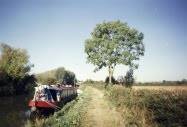
Narrowboat or Narrow Boat?
How does the old song go? You say potato, I say tomato? A narrow boat was traditionally a cargo carrying boat found on the British inland waterways from the 18th century onwards. On the UK navigable waterways locks and bridge holes are a minimum of 7 feet wide. The phrase “narrow boat” often refers to the original style of working canal boat, or a modern replica of this type of boat. The first narrow boats were horse drawn wooden boats. Today on the canal there are many replicas of the traditional type of boats, painted with ornate designs of roses and castles. Some enthusiasts are dedicated to restoring the remaining original boats and The Historic Narrow Boat Owners Club was formed in 1966. It is a not-for-profit club dedicated to preserving the working heritage of the canals.
However, the modern meaning of the term “narrow boat” in The Concise Oxford Dictionary simply reads, “A narrow boat is a canal boat, esp. one less than 7 ft. wide”. British Waterways and magazines like Waterways World have adopted the term “narrowboat” to refer to pleasure boats and live-aboard canal boats that are built with the similar style and dimensions to the old cargo carrying narrow boats. Living on a canal boat is now becoming more and more popular and so used boats for sale, barges for sale and houseboats for sale are just some of the options available to people with an interest in living aboard narrowboats and canal boats. Narrowboats are usually built of steel, although some modern ones are now aluminium. Their size, design and history are completely different to that of long-boats or barges.
Although a narrowboat is defined as being no wider than 7 feet, in practice canal boats are usually 6 feet 10 inches wide to allow them to comfortably cruise the canal system and pass through locks and bridges. Most locks can accommodate narrowboats of up to 70 feet in length. However, a shorter boat will allow a boater the freedom to explore more of the network because some locks on a few isolated waterways can be as short as 40 feet. Anything wider than 7 feet is known as a wide-beam or broad-beam, but can often be similar in style and design to a narrowboat. Although they will have an open front deck, this can be enclosed with a removable water-proof covering called a cratch cover. A traditional narrowboat stern is so short that the helmsman actually stands on the back step, inside the hatch. In a semi-trad boat there is no roof over the engine space and there may be bench seats against the side walls. A cruiser stern provides a larger, open back deck, sometimes with a railing around it.
So from their gritty beginnings as an integral part of the Industrial Revolution narrow boats and canal boats have evolved and diversified. Interest in the leisure boating industry was ignited after the second world war thanks to the enthusiasm of L.T.C Rolt and the IWA, living aboard a narrowboat is still growing in popularity and cargo carrying continues to be a practical use of the inland waterways.
Useful Links
The Historic Narrow Boat Owners Club
]Boatshed Grand Union canal and narrowboats for sale
Old Working Boat Image Credit:
]R.P Marks
Peggy Melmoth
www.narrowboatwife.blogspot.com


